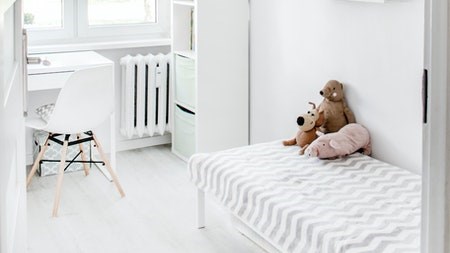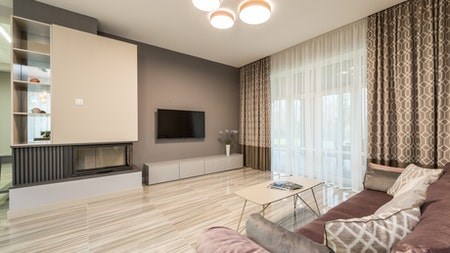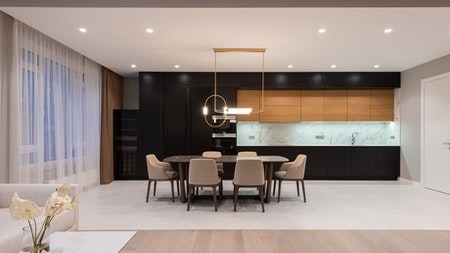Having a little one or two running around your home brings along a whole new level of love and appreciation. You can’t wait to see your kids grow up, experience the world and go on as many adventures as possible. But while they’re still young, you’ll need to keep them safe in your home by making sure your space is baby-proofed.
What does it mean to baby-proof your home?
For many new and inexperienced parents, the concept of baby-proofing your home is very new and unheard of. To baby-proof your home means to make your space as safe as possible for your infants or young children by removing or minimizing any potential hazards. The type of hazards your children can encounter might seem endless, however taking the time to baby-proof your home will set your mind at ease, knowing that your children will be exploring their new home safely.
What are some of the baby-proofing products you’ll need to purchase?
Before you even think about moving into your new home, you’ll need to stock up on some tools to ensure that your baby-proofing mission goes well. Some essential items to buy include:
● Cupboard locks
● Door or stair baby gates
● Power outlet covers
● Baby monitors
● Window screens or window stoppers
● Corner guards to cover sharp edges
● Bed rails
● Smoke alarms
● Toilet lid locks
● Tap covers
Now that you’ve assembled your tools, you are ready to move into your new home. When moving into a new home, there are a few things to keep in mind before, during and after the big move. You’ll want to be prepared for anything while moving into your new home. Some tips to remember before and during the day of your move are:
1.Get prepared before you move
Moving into a new home, especially with younger kids, takes a lot of organizing, energy and time. Especially when a new home needs to be baby-proofed. And so, starting as early as possible is key in successfully moving with younger kids.
If you already have your baby-proofing tools on hand, such as baby gates, cabinet locks and outlet protectors, make sure to pack them in clearly labeled boxes and have them moved with the rest of your belongings. Either you can pack the baby-proofing boxes in your car or load them last in the moving trucks so that it’s the first thing being unloaded. It’s easier to baby proof a home before all of your belongings are there, as they might get in the way.
2.If possible, arrange for your kids to be looked after on moving day
Moving day can quickly become chaotic, to say the least. Between the army of men unloading boxes from the moving trucks and you trying to keep everything as organized as possible, it’s easy to become lost in the process and overlook the fact that your kids need to be supervised. And throw in the task of baby-proofing the home amidst the chaos? Welcome to Mission Impossible.
To make things easier, have the kids spend the day with a trusted friend or family member. That way, you know your kids are being looked after, while you have the time to prepare your new home. With your kids being out of the way, take the time to explain to the movers where all of the boxes and furniture need to be placed. While they are busy unloading, you have the time to go about the house and start some necessary baby-proofing activities. As they say, teamwork makes the dream work.
3.Create a separate unpacking space
Kids see many things as toys to play with. Bubble wrap and empty boxes especially. But between the millions of empty boxes are dangerous things such as plastic wrap, staples, box cutters and scissors. A definite no-no for any child. To keep the peace in the house, create a designated unpacking space.
If you have an empty room in the house, such as the spare bedroom or the garage, make that space your designated unpacking area. Choose a room that has a lock on the door to keep little hands away from any dangerous tools. You can use this space to tear boxes open and unpack all that needs unpacking while being reassured that the kids won’t get ahold of any sharp objects. If you don’t have an open space and need to unpack around your kids, make sure to keep your unpacking tools in locked cabinets or high shelves when taking a break from unpacking.
4.Gate it off
Baby gates are your new best friend. They keep your children safe from any unwanted dangers while still allowing you to keep an eye on them. A very good investment in our eyes. While moving into your new home, make use of the baby gates to secure various arrears that are a no-go for the kiddies.
If you have a two-story home, gate off the stairs to keep your children safe on the ground floor where you can keep an eye on them. If you still need to baby proof the ground floor, such as covering any open outlets, gate your kids off in the living room. Put on their favourite movie or give them some empty boxes to build a fort with while you get busy on making your home safe. Baby gates are fantastic in keeping your kids in one location while you get to baby-proofing.
Now that you’ve officially moved into your new home, you now have the time to baby-proof every single space as much as possible. You’ve settled in enough to know what you’ll be working with and what is still needed in order to create a safe space for the little ones. Some ideas include:
Cover outlets and ensure electrical safety
Covering power outlets is probably one of the most important baby-proofing activities when moving into a new home. It may seem like a tedious task, however going through each individual room and covering up every open power outlet will ensure that your children can move about their new home safely.
Go through each room and check which power outlets are reachable by your children. Now, cover every single one of them. If you don’t have enough covers, keep some rooms off limits until you get the job done. As a mom, you will breathe easy knowing your kids won’t stick their fingers in holes where they don’t belong.
heck windows and sliding doors
An important thing that many parents forget to baby proof are some of the windows and sliding doors in a new home. Not all windows and doors need to be locked 24/7, but it’s important to walk through the house and baby proof all of the hazardous windows and sliding doors.
If you live in a second story home, all of the windows and doors on the top floor need to be baby proofed immediately. Install a child proof lock on all of the sliding doors to ensure your children don’t go onto the balconies. If you have any windows, try installing some window screens or window stops. That way, you can leave your windows open for some fresh air while ensuring the kids don’t squeeze through any open windows. Window stops are great to install on the first floor as well, as this will allow you to keep your windows open, but small enough so that children can’t fit through.
Don’t keep boxes stacked
Any mom knows that children love to explore. Especially when they start to walk. To prevent any unnecessary falls, never leave any boxes stacked while moving into your new home. Let’s be honest, to a little kid a tower of boxes is just asking to be climbed. Remove any climbing temptations by spreading your moving boxes across the floo, or even consider leaving any unpacked boxes in a locked room. This way, both of your belongings and your beloved children are out of harm's way.
Be on the lookout for any loose cords or strings
This small detail is something that can be overlooked sometimes, however is very important to keep in mind when creating a safe environment for the little ones. Any loose cords or strings can pose a great threat and needs to be handled immediately.
Take a walk through your new home and look for any hazardous cords, such as extension cords or cords hanging from your newly installed blinds. If you have blinds, take the time to tie the cords at a length where your children won’t be able to reach them. This eliminates the idea of your children getting stuck between the ropes or choking on them if they ever go around their bodies. If you have any electrical cords or extension cords, take the time to tape them down to the floor or walls, or remove them entirely. If you have any appliance that you don’t use regularly, consider storing the appliance to eliminate the danger of children pulling on the cords.
Always keep a fully stocked first aid kid
No matter how hard we try to protect the kiddies, accidents are bound to happen. Whether it’s a burnt finger or a scraped knee, it’s important to always have a fully stocked first aid kit on hand. Make sure to include various supplies such as plasters, bandages, safety pins, burn ointment etc. to counteract any accidents that may occur. Keep the first aid kit on a high shelf or in a locked cupboard.
Now that we’ve covered some basic child-proofing tips, lets chat about each and every common area in your home and how you can make each space safe for the little ones:
1.The nursery or bedroom
The nursery or bedroom is arguably the room where your little one will spend the majority of their time. From playing to sleeping, it’s important to make sure your child’s own space is safe for them to avoid any unnecessary accidents. Some important things to add to the room are:
● A thick carpet next to your child's crib or bed to ensure they don’t get hurt when they have an accidental fall
● Install window stoppers or locks for those curious little ones
● Ensure all outlets are covered or closed off
● Install a railing around your child’s bed or crib
● Install a baby monitor to keep an eye on them while they are alone and sleeping
2.The living room
Your living room is a place for relaxation and where the family can get together to spend some quality time together. However, every mom knows that babies and small children are prone to accidents, even in this seemingly harmless room. Some things you can do to ensure your little one’s safety include:
● Covering all exposed power outlet
● Placing corner guards on sharp edged, such as your coffee table or entertainment unit
● Keep all remotes out of your child’s reach to ensure they don’t get ahold of any batteries
● Secure any large objects, such as a bookcase of your television, securely to the wall to prevent anything from tipping over.
● Make sure to pick up any small, choke-able items off of the floor or coffee table before your child enters the room
3.The bathroom
The only time your toddler or baby should ever be in the bathroom is when they need to bathe or when they are being potty trained. However, in both cases your baby or toddler should never be alone and try to keep it that way. A bathroom can be a very hazardous space for any small child, so make sure to keep the area restricted until your children are a bit older. Some things to consider when your child is in the bathroom include:
● Keeping all cleaning products or medical supplies out of reach or in locked cabinets
● Adding a slip-resistant mat to the bathtub or bathroom floor
● Never leaving your child unattended when they are in the bath
4.Tackling the kitchen
The kitchen is probably one of the rooms with the most potential hazards in your entire house. Electrical appliances, fire hazards, choking hazards, the list just goes on. So, when moving into your new home, it’s important to set out time, especially to get the kitchen as safe as possible. Some tips to keep in mind include:
● If you have any cabinets or drawers your toddler or baby can reach easily, install a child lock to prevent them from getting ahold of any sharp objects or dangerous cleaning chemicals.
● If you have any kitchen appliances with electrical cords, store them in higher places if they’re not being used, or push them towards the wall, as far away as possible from the counter’s edge.
● Keep a fire extinguisher on hand and know when to use it.
● If you use a feeding chair in the kitchen, make sure to place it in an area where it won’t tip over and always make sure to strap your kids in to prevent them from falling.
● Cover any low open power sources (we can’t stress this enough!)
5.Walk around your house and make some changes in the garden
Every child, young or old, loves to spend some time in the garden and get some well-deserved playtime and vitamin D. However, having younger kids or babies means that you’ll need to baby-proof the garden as well. If you have a pool, you’ll need to either cover the pool or build a fence around it. If you have a fence, make sure the pool is locked at all times and that it can only be opened by you or your partner. Ensure that all gardening tools and supplies are locked away in a safe space, either outside or inside your home. These small things will ensure that you can breathe easy while your kids enjoy some fun in the sun.
If you ever feel like you can’t baby-proof your house alone, consider hiring a professional! That’s right, hire a professional. You can hire a professional consultant to come and inspect your home and they will advise you on what needs to be done and the different ways you can assure your home is completely babyproof. They will provide an in-depth safety checklist and can help you to source all of the items you’ll need to make your home as safe as possible.
Babyproofing, especially for first time parents, might seem like an endless mission with millions of things to do and get right. But, with careful consideration and planning, you will get the job done way faster than you thought possible. Also, don’t be afraid to enlist the help of some friends or family members. Babyproofing a home takes team efforts, but will be all worth it in the end.
Read more here.
Writer : Biggles Movers




